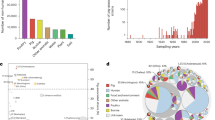Abstract
INITIAL reports of the salmon disease from Ireland suggested that the problem was purely bacteriological. This was despite the fact that the presence of a fungus, Saprolegnia, constituted the only clear outward symptom by which the disease was recognized. Stuart and Fuller have discussed the possible role of the fungus more realistically and have given details of their mycological researches1. With the advent of the disease to the English Lake District, especially in the autumn of 1967, I have also had the opportunity to make observations, and these to some extent parallel those of Stuart and Fuller. Further details of the fungus have, however, become known. Saprolegnia isolates were made from diseased salmon, trout and char (Salvelinus willughbii) netted in Windermere, and from further specimens of the latter which succumbed in hatchery ponds immediately adjacent to our laboratory. The water supply for the hatchery ponds derives directly from Windermere and is untreated. Using GYS-tellurite agar, a medium previously employed for ecological studies on the Saprolegniaceae2, the isolates were soon free of bacteria and sterilized hemp seeds were added. These were removed after 8 h and transferred to dishes of sterile lake water where they grew abundant fringes of the fungus. These growth fringes produced sporangia releasing zoospores, but not oogonia. In the absence of these any specific epithet which may be applied to the purely asexual condition (for example, Saprolegnia parasitica) can have little or no meaning or usefulness. Accordingly attempts at oogonial induction were set in hand, using oatmeal and cholesterol3 agars of different strengths with single or paired isolates. Isolates were also paired in simulated natural conditions in contact with sterile mud or soil, following the method of Sherwood4 for Dictyuchus. All these attempts were unsuccessful.
This is a preview of subscription content, access via your institution
Access options
Subscribe to this journal
Receive 51 print issues and online access
$199.00 per year
only $3.90 per issue
Buy this article
- Purchase on Springer Link
- Instant access to full article PDF
Prices may be subject to local taxes which are calculated during checkout
Similar content being viewed by others
References
Stuart, M. R., and Fuller, H. T., Nature, 217, 90 (1968).
Willoughby, L. G., and Collins, V. G., Nova Hedwigia, 12, 149 (1966).
Waterhouse, G. M., Mycol. Papers, 109 (1967).
Sherwood, W. A., Mycologia, 58, 215 (1966).
Park, D., Trans. Brit. Mycol. Soc., 46, 541 (1963).
Huxley, T. H., Quart. J. Microsc. Sci., 22, 311 (1882).
Coker, W. C., The Saprolegniaceae (University of North Carolina Press, 1923).
Author information
Authors and Affiliations
Rights and permissions
About this article
Cite this article
WILLOUGHBY, L. Atlantic Salmon Disease Fungus. Nature 217, 872–873 (1968). https://doi.org/10.1038/217872a0
Received:
Issue Date:
DOI: https://doi.org/10.1038/217872a0
This article is cited by
-
Experimental transmission and pathogenicity of some zoosporic fungi toTilapia fish
Mycopathologia (1995)
-
Studies on species of fungi associated with mycotic infections of fish in a Nigerian freshwater fish pond
Hydrobiologia (1991)
-
Polycell-gel assay of water for spores of Saprolegniaceae (fungi), especially those of the Saprolegnia pathogen of fish
Hydrobiologia (1984)
-
Immunochemical investigation of four Saprolegnia species with parasitic activity in fish: Serological and kinetic characterization of a chymotrypsin-like activity
Microbial Ecology (1977)
Comments
By submitting a comment you agree to abide by our Terms and Community Guidelines. If you find something abusive or that does not comply with our terms or guidelines please flag it as inappropriate.



